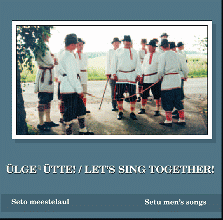 Paul Hagu (producer)
Paul Hagu (producer)Hoi ta_ks velekeisi vai! noorõ-jallõ-kõisi (Hey, young men!) CD. Recording by Jaan Tamm. Setomaa, 2000. The album contains 24 Setu songs mostly from Uusvada and Meremäe, but some also from Helbi, Värska and even Tallinn. The songs were recorded during 1972-1999. The style of men's singing is truly awe-inspiring. It is thrilling like a lion's roar and tense like an arrow ready to be shot, offering enchanting fioriture - glissandi and melismata, calls and embellishments. Even an Italian tenor would bow to the richness of artistic expression that these old men's songs entail. The fact that the lyrics are often inaudible is part of its charm. As to the tunes of the men's songs the available material suggests that there are only two melody tunes. The first is actually a bachelor song, and is called kul'atamine in the Setu-Võro dialect. The tune begins with a move to the fifth from the tonic, quavers around the highest note and falls only to let the killõ catch the note and add another bright almost voice-breaking high note. The aim of the bachelor song seems to have been making oneself heard and identifying oneself through one's voice. When unmarried young men went to walk around the village in the evening, the song preceded them and it had to be heard far ahead. The result was astonishing. I remember it from my own experience during the first recording sessions in the assembly hall of the school of Meremäe in July 1972. The voices of these seven aged men were even more powerful than was needed to fill the whole hall. The second tune is actually the proper melody of the men's song. Its lyrics are bound with the song and singing and it is called ilopidämine. This tune is less extravagant, using mostly the lower tones of the scale, and even the pitch pattern first descends and only then the tune slightly touches the peak. The melody of men's song is low and its true effect is hidden. Both tunes remind the listeners of the Phrygian mode that uses 5-6 degrees. Men have also performed at weddings and other festive celebrations, though often accompanying female singers. On this cassette the song type is represented by songs with female soloists. Female singers may sometimes even perform the part of killõ. On such occasions the songs are performed to different, in fact, women's tunes that require voices with less strength and endurance, but where lyrics are of greater importance. Studying the lyrics of the Setu men's song one cannot help noticing the plethora of extra syllables and recurrent words. Instead of the 9-11syllabic notes typical of the women's song the men's song contains 13-15 or even more syllabic notes. This explains why it is often hard to listen to the lyrics of men's song, although with attentive listening it should be possible to distinguish at least some words. The songs speak about desiring the purple woman, laughing at an old maid and bachelor, recalling warfare in Transvaal and searching for the grey mouse. I was most astonished at discovering two field songs, which are very rare, perhaps even unique in the Estonian folklore tradition. The contribution of Paul Hagu is immense - he has collected 120 Setu men's songs, systematising these by tunes. Relying on the long tradition he has described the very essence of the men's song tradition and has arranged the songs in successive order to achieve melodic harmony. Indeed, it sounds good and we must only hope that the Setu men's song will be heard not only on this tape but elsewhere too. We need more of these songs that render men so strong and powerful. Vaike Sarv |